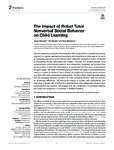The Impact of Robot Tutor Nonverbal Social Behavior on Child Learning
| dc.contributor.author | Kennedy, J | |
| dc.contributor.author | Baxter, P | |
| dc.contributor.author | Belpaeme, T | |
| dc.date.accessioned | 2017-04-26T15:19:08Z | |
| dc.date.available | 2017-04-26T15:19:08Z | |
| dc.date.issued | 2017-04-24 | |
| dc.identifier.issn | 2297-198X | |
| dc.identifier.issn | 2297-198X | |
| dc.identifier.uri | http://hdl.handle.net/10026.1/9124 | |
| dc.description.abstract |
Several studies have indicated that interacting with social robots in educational contexts may lead to a greater learning than interactions with computers or virtual agents. As such, an increasing amount of social human–robot interaction research is being conducted in the learning domain, particularly with children. However, it is unclear precisely what social behavior a robot should employ in such interactions. Inspiration can be taken from human–human studies; this often leads to an assumption that the more social behavior an agent utilizes, the better the learning outcome will be. We apply a nonverbal behavior metric to a series of studies in which children are taught how to identify prime numbers by a robot with various behavioral manipulations. We find a trend, which generally agrees with the pedagogy literature, but also that overt nonverbal behavior does not account for all learning differences. We discuss the impact of novelty, child expectations, and responses to social cues to further the understanding of the relationship between robot social behavior and learning. We suggest that the combination of nonverbal behavior and social cue congruency is necessary to facilitate learning. | |
| dc.format.extent | 6- | |
| dc.language.iso | en | |
| dc.publisher | Frontiers | |
| dc.subject | 46 Information and Computing Sciences | |
| dc.subject | 4608 Human-Centred Computing | |
| dc.subject | Behavioral and Social Science | |
| dc.subject | Mental Health | |
| dc.subject | Basic Behavioral and Social Science | |
| dc.subject | Pediatric | |
| dc.title | The Impact of Robot Tutor Nonverbal Social Behavior on Child Learning | |
| dc.type | journal-article | |
| dc.type | Journal Article | |
| plymouth.issue | 6 | |
| plymouth.volume | 4 | |
| plymouth.publisher-url | http://dx.doi.org/10.3389/fict.2017.00006 | |
| plymouth.publication-status | Published | |
| plymouth.journal | Frontiers in ICT | |
| dc.identifier.doi | 10.3389/fict.2017.00006 | |
| plymouth.organisational-group | /Plymouth | |
| plymouth.organisational-group | /Plymouth/Faculty of Science and Engineering | |
| plymouth.organisational-group | /Plymouth/Research Groups | |
| plymouth.organisational-group | /Plymouth/Research Groups/Marine Institute | |
| plymouth.organisational-group | /Plymouth/Users by role | |
| dcterms.dateAccepted | 2017-03-29 | |
| dc.identifier.eissn | 2297-198X | |
| dc.rights.embargoperiod | No embargo | |
| rioxxterms.versionofrecord | 10.3389/fict.2017.00006 | |
| rioxxterms.licenseref.uri | http://www.rioxx.net/licenses/all-rights-reserved | |
| rioxxterms.licenseref.startdate | 2017-04-24 | |
| rioxxterms.type | Journal Article/Review | |
| plymouth.oa-location | http://journal.frontiersin.org/article/10.3389/fict.2017.00006/full |


